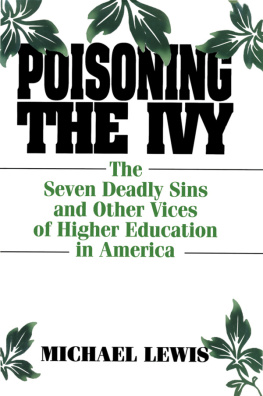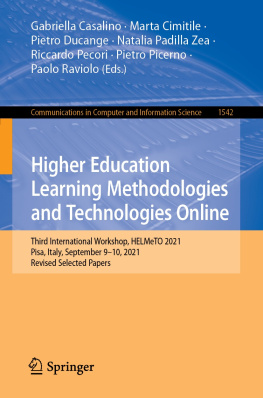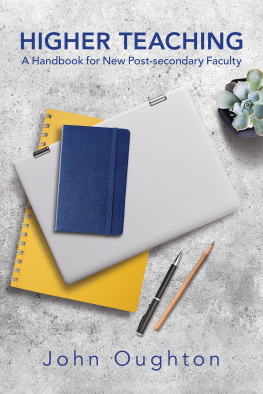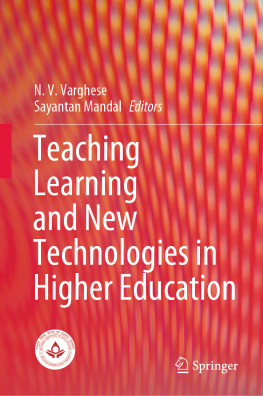Cover
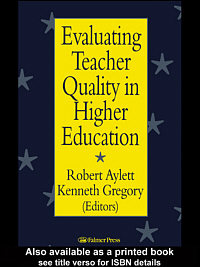
| title | : | Evaluating Teacher Quality in Higher Education |
| author | : | Aylett, Robert; Gregory, Kenneth |
| publisher | : | Taylor & Francis Routledge |
| isbn10 | asin | : |
| print isbn13 | : | 9780203289075 |
| ebook isbn13 | : | 9780203299432 |
| language | : | English |
| subject | College teachers--Rating of--Great Britain, Higher education institutions--Teaching , England , Wales |
| publication date | : | 1996 |
| lcc | : | LB2333.E937 1996eb |
| ddc | : | 378.007042 |
| subject | : | College teachers--Rating of--Great Britain, Higher education institutions--Teaching , England , Wales |
Page i
Evaluating Teacher Quality in Higher Education
Page ii
This page intentionally left blank.
Page iii
Evaluating Teacher Quality in Higher Education
Edited by
Robert Aylett and Kenneth Gregory

The Falmer Press
(A member of the Taylor & Francis Group)
London Washington, D.C.
Page iv
UK Falmer Press, 1 Gunpowder Square, London, EC4A 3DE
USA Falmer Press, Taylor & Francis Inc., 1900 Frost Road, Suite 101,
Bristol, PA 19007
R.Aylett and K Gregory 1996
All rights reserved. No part of this publication may be reproduced, stored
in a retrieval system, or transmitted in any form or by any means, electronic,
mechanical, photocopying, recording or otherwise, without permission in
writing from the Publisher.
First published in 1996
This edition published in the Taylor & Francis e-Library, 2003.
A catalogue record for this book is available from the British
Library
Library of Congress Cataloging-in-Publication Data are available on
request
ISBN 0-203-20920-6 Master e-book ISBN
ISBN 0-203-28907-2 (OEB Format)
ISBN 0 7507 0577 9 cased
ISBN 0 7507 0578 7 (Print Edition) paper
Jacket design by Caroline Archer
Page v
Contents
Preface | vii |
| Introduction: The Evaluation of the Teaching of Individual Academics in Higher Education: Progress Towards a Construct
Ken Gregory | |
| Assurance of Teaching Quality: Top-Down and/or Bottom-Up Strategy
Eric A.Ash | |
| Quality Assessment in Higher Education in England: Present Performance, Future Perspectives
Paul M.Clark | |
| Teaching Profiles: The Quality Context
Roger Brown | |
| Criteria for Teaching Competence and Teaching Excellence in Higher Education
Lewis Elton | |
| Promoting Excellent Teachers at Oxford Brookes University: From Profiles to Peer Review in Ten Years
Graham Gibbs | |
| Contributions on Specific Aspects from Particular Institutions: | |
7.1 The Programme for Staff with Teaching Responsibility
David Buckingham | |
7.2 Developing, Recording and Recognizing Good Teaching
George Gordon | |
7.3 Documenting and Assessing Teaching Excellence
Dai Hounsell | |
7.4 The Use of Standard Course Evaluation and a Standard CV
H.Mathias | |
7.5 Course Innovation: Benefits and Risks
Roy Haines-Young | |
| Quality Assurance at MacQuarie University
Alan Lindsay | |
Page vi
| Successfully Creating a Customer Focused Culture Throughout Your Organization and Effectively Managing the Change
Colin M.LivingstoneandWayne M.Phillips | |
| The Individual and the Institution: Quality Management in Higher Education
Bob AylettandDerek Hilyer | |
| A Construct for Teaching Profiles (containing reports from convenors of discussion groups)
Ken Gregory | |
| The Prospect
Bob AylettandKen Gregory | |
List of Conference Participants | |
Index | |
Page vii
Preface
The idea for a meeting concentrating upon the teaching profile for individual academics in higher education arose in 1993, and was prompted by two main considerations. Firstly, because we at Goldsmiths College, University of London, were becoming increasingly aware of the desirability of developing a method for expressing the teaching profile of the individual academic in relation to the implementation of more sophisticated promotions procedures, and also in relation to staff development. Secondly, because we were aware that many developments were taking place in other universities, and were at various stages of construction, and it seemed that an attempt to coordinate knowledge, to establish how much progress had been made, and to share best practice between institutions, might be timely and useful. A one-day conference was therefore organized on 19 May 1994 and this benefitted enormously from collaboration with IBM, particularly Mr Wayne Phillips.
We are extremely grateful to colleagues who contributed to the programme on the day, in terms both of their lectures and their subsequent contributions to the discussions, and we very much appreciate the active involvement of all the participants at the conference, particularly in their respective discussion groups. Some thirty-five universities were represented by individual members of staff, and we feel that in this respect the conference was able to reflect developments taking place across a broad range of higher education institutions.1
Prior to the conference, it had been proposed that a volume of proceedings and other essays emerge, and we are particularly grateful to Taylor & Francis, and especially to Mr Stephen Neal, for making this possible. In this context, thanks are due to Mrs Sue Boswell, Head of Secretariat and External Relations, for arranging the transcription of the discussion, as well as to Ms Anne Duggan for dealing so effectively with some of the textual problems involved. A number of Goldsmiths staff, especially Mrs Boswell, were responsible for much of the organization and preliminary arrangements for the conference, and again we wish to express to them our thanks.
The structure of this volume does not perhaps reflect that of a typical volume of conference proceedings. The subject is dynamic; parts of the terrain remain largely unexplored; developments continue to take place. We have structured the volume to embrace a wide range of approaches and perspectives: formal and highly structured contributions from eminent authorities are juxtaposed with detail from discussion sessions in order to maximize the number of issues raised and to seek to ensure that the volume will be of wide interest.
Next page



